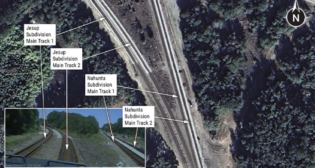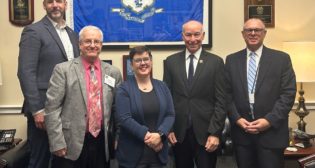
Add That to Your Treasure Trove of Useless Excel Spreadsheet Information
Written by David Schanoes, Contributing Editor
You’re probably not reading it here first, particularly if you start your days or nights with the Federal Register summary page of new and exciting government rules, proposals, notices, regulations etc., but the Federal Railroad Administration is seeking approval of, and requesting comment on, an Information Collection Request. Because all things cost, but not all things benefit, the payer, the ICR is submitted to the OMB (Office of Management and Budget) for approval, thus proving that money retains it place at the top of the pop chart, Number 1 with a bullet, and is unlikely to be dethroned in our lifetime.
The new information requested for collection is a reporting requirement charged to the six remaining Class I railroads that mandates monthly submissions of “data regarding total number of trains operated, the total number of cars in those trains, as well as the total trailing tonnage in specified train length categories (e.g., less than or equal to 7,500 feet, greater than 7,500 feet).”
But that’s not all: “In addition, FRA proposes to collect data from Class I freight railroads that may inform potential complexities and safety concerns associated with operating longer trains, such as the number of emergency events (emergency what? brake applications? “emergency” is not defined in this ICR), the number of communication event losses (again undefined), the number of broken knuckles, the number of air hose separations, the number of PTC enforcements, and the number of locomotive engineer revocations (FRA omits the word “certification”; engineers don’t get “revoked”, engineer certifications do). The requested data will be collected monthly using an Excel-based form (Form FRA F 6180.277).”
And there’s more: “This data collection is necessary to allow objective findings to be made that can be used to either justify the status quo or to provide justification for further recommendations or agency action. Of note, FRA is seeking to collect data on train length on an ongoing basis, as opposed to this being a one-time study. FRA will use the collected data to establish an initial baseline for the length of trains operating within the U.S. rail system as well as to determine if train lengths are changing over time. FRA may also use the collected data in future analyses to better understand the impact of train length on safety (e.g., to determine whether trains of certain lengths are disproportionately involved in certain types of accidents/incidents or other undesired events such as loss of communications or train stalling).”
Well, I don’t think FRA F 6180.277 exists yet, but I will note that “train stalling” was not included in the roster of “complexities” and “concerns” itemized earlier in the notice.
It would be a sign of small-mindedness to think this ICR is designed to give the impression that FRA is busy collecting, reviewing, assessing, and making determinations based on this data, because in reality, this ICR is so poorly worded and the categories of data so diffuse as to prevent the so-called target—the relation of train length to train safety—from being reached, thus allowing FRA to do anything—or nothing.
But who among us is that small-minded?
I’m not, but I am downright incredulous when I read: “FRA has incorporated several measures to minimize the respondents’ paperwork burden in this proposed collection. For example, to avoid duplicating efforts, FRA is not asking railroads to provide train length information for any FRA-reportable accident or incident for which a form F6180.54 is filed. Instead, for any train involved in an accident for which a form F6180.54 is filed, FRA will review train length data collected on that form and will not seek to collect the same data proposed in this collection.”
Seriously? Saves time? Only if FRA goes about things ass-backwards, which is painfully clear to the most casual observer, because the collection of these ill-worded measures only has meaning if the target incidents increase the frequency and/or severity of reportable accidents. Such additional reporting, including train length and prior unusual occurrences, should be added and limited to events that trigger the submission of Form 6180.54.
I calculated several months ago from data provided to and by the Surface Transportation Board that Class I railroads initiate approximately 1,920 daily main track train “starts.” Suppose 35% of these starts are of trains greater than 7,500 feet. That’s 672 starts daily, or 20,160 starts over a 30-day period. Let’s be conservative and presume only 10% or 2,016 trains experience a single incident each.
So first we report the total number of train starts in 30 days; then the number of trains with lengths less than 7,500 feet; and then the number more than 7, 500 feet. Then we think we can learn something if we provide details of the targeted irregularities for those longer trains. And we can learn something. We just can’t learn enough. So after taking off my DOT baseball cap to scratch my head, I get an idea. We’ll have railroads report the targeted irregularities for all trains, those less than 7,500 feet and more than 7,500 feet in length. Then we can compare and calculate the different frequencies of occurrence and see if the rates have any unique relation to train length. That’s the ticket. I’ve stuck in my thumb and pulled out a plum and I’m a good boy, ain’t I? (Rhetorical question. Do not feel obligated to answer.)
Goodbye paperwork reduction. Good-bye total annual burden of 576 hours.
We now have a pool of 57,600 trains every 30 days. If 10% experience the targeted incidents, that’s 5,760 trains. And? And just based on my experience with FRA, there’s no way FRA will be able to process that data before the next 30-day batch rolls in. No way.
Hell, no one at FRA could provide an answer to the simple question of how many daily train starts are initiated by the Class I’s.
I won’t even bring up the quality and timeliness of the response to questions about PTC reliability I raised in the recent past.
You get the Class I’s expending large amounts of effort assembling this data, and then dumping the data to FRA, and then … who knows?
But we do know that even that detail doesn’t provide a basis for actual comparison and contrast because trains are not static fixed entities. They have varying mass that travels over varying distances at various speeds, so the real denominators for determining frequencies would be derived from total ton-miles operated by trains of the specified lengths: ton-miles for all trains of a certain length, divided by trains operated of the specified length; average ton-miles for trains less or greater than 7,500 feet. Then we calculate the rates of each targeted occurrence as incidents per ton-mile.
Tranche de gâteau, as they say on the SNCF.
Oy Vey! as we say in New York City.
Or we can just include this information for main line non-highway grade crossing accidents that trigger the reporting requirement. We should be able to see if the frequency follows any relation to length and weight, and if the average cost of each incident follows along.
Simpler is better … in the beginning. Good railroading is a simple business. FRA’s ICR as currently proposed is neither.

David Schanoes is Principal of Ten90 Solutions LLC, a consulting firm he established upon retiring from MTA Metro-North Railroad in 2008. David began his railroad career in 1972 with the Chicago & North Western, as a brakeman in Chicago. He came to New York in 1977, working for Conrail’s New Jersey Division. David joined Metro-North in 1985. He has spent his entire career in operations, working his way up from brakeman to conductor, block operator, dispatcher, supervisor of train operations, trainmaster, superintendent, and deputy chief of field operations. “Better railroading is 10% planning plus 90% execution,” he says. “It’s simple math. Yet, we also know, or should know, that technology is no substitute for supervision, and supervision that doesn’t utilize technology isn’t going to do the job. That’s not so simple.”



